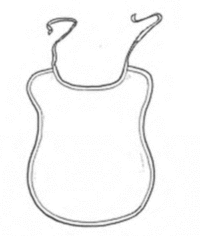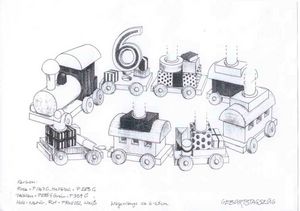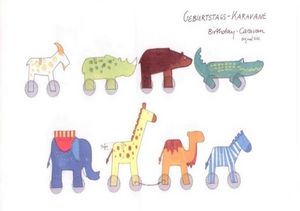Overview of German copyright law
Origin and scope of copyright protection
| Brief description of copyright law: | Unregistered protection for individual intellectual works |
| Protected objects: | Works, examples: Photographic works, photographic images, texts, pieces of music, works of art, speeches, photographs, films, texts, drawings, city maps, stage plays |
| Protection requirement: | "Level of creation", but also "small coin" for linguistic works. Exception: Photographs (e.g. product photos) |
| Creation of copyright: | Creation of the work, no registration necessary or possible |
| Duration of protection: | From creation until 70 years after the death of the author (§ 64 UrhG), for photographs until 50 years after publication (§ 72 III UrhG) |
| Territorial scope of protection:: | Germany |
| Material scope of protection: | "Overall impression expressed in the concrete design in its creative individuality" (cf. RGZ 155, 199, 202 f. - Möbelstoffmuster); protection of form and content, also in the area of similarity; the more complex the work, the greater the scope of protection |
| Typical problems with copyright infringement: | Level of creation |
Terms of copyright law
Works
The results of personal intellectual creation (cf. Section 2 II UrhG), i.e. texts, product descriptions, graphics, drawings and films, are eligible for copyright. These are referred to as "works". In principle, every work of literature, science and art that is individual and has "level of creation" is protected.
Copyrightable works may only be used with the consent of the rights holder. Licensing such a work is almost always cheaper than paying compensation.
Examples
The following are protected by copyright
- Photographs of any kind ("photographs" and "photographic works")
- Texts
- Film works and stills/screenshots thereof
- Fine art (works of art)
- drawings
- City maps (Section 2 I No. 7 UrhG; BGH of 26.2.2014 - I ZR 121/13 - Copyright protection of online city maps)
Designs can also be protected by copyright. However, they usually lack the "level of creation" required for copyright protection (see below). They are therefore often protected as registered designs or registered or unregistered Community designs. Individual words or terms are not eligible for copyright protection. However, protection as a trademark or other distinctive sign is possible.
Level of creation
For a work to be protected by copyright, it must have a sufficient "level of creation". It must be a "personal intellectual creation" (cf. Section 2 II UrhG). A certain level of individuality and design is meant by level of creation. The work must be an expression of the author's individuality, so to speak. This means that only the result of a non-everyday intellectual activity is eligible for protection. What is commonplace or created by hand is not protected per se. However, these requirements are reduced for certain areas. For example, advertising texts from online offers are also protected as "small coin" as linguistic works (OLG Düsseldorf v. 6.5.2014 - I-20 U 174/12 - Offer text for lawyers' robes). The level of creation can result solely from the division and arrangement of the text. City maps and photographs are also protected. In the latter case, a distinction is made between photographs that are the result of a personal intellectual creation ("photographic works", Section 2 No. 5 UrhG) and the (simpler) "photographs" (Section 72 UrhG). A photograph does not have to be the result of a personal intellectual creation. Even a photo of a banal cheese sandwich (see BGH of 12.11.2009 - I ZR 166/07 - marions-kochbuch) is therefore protected by copyright, as is any product image, even if it was created in a photo box.
Origin of copyright
Date of origin
Copyright protection arises when the work is created. The entry of a work in a register is neither intended nor possible for copyright protection. Such a register does not exist in Germany. Nor is the popular marking of a work with the © necessary. However, this can be part of a copyright notice (see below).
Copyright notice
Such a marking together with a name can, however, constitute a copyright notice. In the event of a copyright infringement, this saves the rights holder the often difficult task of proving that they are the author until proven otherwise. This is because a copyright notice creates a legal presumption that the person named is actually the author (see the presumption of authorship or ownership of rights in Section 10 UrhG).
Changes, adaptations and free use in copyright law
Principles of adaptations in copyright law
The modification or adaptation of a copyrightable work is also only permitted with the consent of the author (Section 23 UrhG). An adaptation or alteration of a copyright-protected work that has not been authorized by the author is itself a copyright-infringing reproduction (BGH of 16.5.2013 - I ZR 28/12 - Beuys-Aktion).
"Free use" according to Section 24 UrG
So-called "free use" is permitted. Anyone who uses another work only as a suggestion for their own adaptation may use the third-party work. According to case law (BGH of 28.7.2016 - I ZR 9/15 - trimmed to bold), the prerequisite is that
- the protected work only serves as a suggestion for the adaptation, i.e. it only "shines through"
or
- the adaptation clearly takes over the protected work, but the artistic examination requires that the protected work is recognizable (e.g. as an "anti-theme or parody")
and
- interests of the author worthy of protection, which speak against alienation, are not infringed.
In principle, there is no free use of melodies. Anyone who uses a recognizably peculiar melody as a suggestion for a jingle, for example, always needs the consent of the rights holder (Section 24 II UrhG).
Copyright infringements
Reproduction right and right of making available to the public
An author has numerous rights to exploit their work. The right of reproduction (Section 16 UrhG) and the right of making available to the public (Section 19a UrhG) are particularly relevant in the field of advertising.
The right of reproduction concerns the copying of a protected work, also by reproduction, for example in a newspaper (BGH of July 1, 1982 - I ZR 119/80 - Presseberichterstattung und Kunstwerkwiedergabe II). The right of making available to the public is the right to publish something on the Internet.
"Framing" ("embedding") and copyright: "New audience" reached?
Copyright-protected content on a website is often embedded in a frame on another website with the help of a script. Such content can be a YouTube video or an Amazon offer as an Amazon affiliate. A publication in a frame only constitutes making available to the public in breach of copyright if a protected work is reproduced for a "new public", i.e. for an audience that the copyright holder did not have in mind and for which he had not granted permission when he permitted the original communication to the public (ECJ of 26.4.2017 - C-527/15 - Stichting Brein/Wullems). Framing therefore does not constitute making available to the public by the person who embeds content using a frame if this does not reach a new audience. The content of the frame is not itself reproduced publicly in breach of copyright (see ECJ of 21.10.2014 - C-348/13 - BestWaterInternational). Embedding is therefore permissible if the author has permitted free availability of the work on the internet to an indefinite audience. In this case, no new audience can be reached by framing (Federal Court of Justice of 9.9.2021 - I ZR 113/18 - Deutsche Digitale Bibliothek II).
However, framing is also a copyright infringement if the embedder knew or should have known that the embedded content was unlawfully reproduced publicly. Anyone acting commercially, i.e. with the intention of making a profit, is obliged to investigate whether the content has been published without authorization (ECJ loc. cit. - Stitching Brein/Wullems, para. 49 ). According to German case law, however, this obligation should not apply if a rights search is not reasonable.
Example (LG Hamburg v. 13.6.2017 - 310 O 117/17 - pug photo):
An Amazon affiliate automatically embedded an Amazon offer on its website. It contained a case for an iPhone on which a dog's head was depicted. The photographer of the dog's head had not consented to its use on the iPhone case. However, this is not said to have been a copyright infringement. This is because the embedder could not reasonably be expected to search for the rights: With minimal remuneration per click, comprehensive searches were unprofitable.
Copyright protection of product images
Photographs and photographic works
Copyright law distinguishes between two types of photos: artistic photos are "photographic works" (Section 2 (1) No. 5 UrhG), non-artistic photos are "photographic images" (Section 72 UrhG). They differ practically only in the duration of protection. Photographic works are protected until 70 years after the death of the author. Photographic works are protected for 50 years after the death of the author. Even the motif itself may be protected by copyright. Even a re-enactment of the motif can constitute a copyright infringement (LG Düsseldorf v. 8. 3. 2006 - 12 O 34/05 - TV-Man), as can the re-photographing of a motif from the same perspective and in the same way (BGH v. 5.6.2003 - I ZR 192/00 - Hundertwasser-Haus). Screenshots from films (film stills) are also protected by copyright, namely as photographs (BGH of 6.2.2014 - I ZR 86/12 - Peter Fechter). Most product images are protected as photographs.
Any photo, no matter how banal, is protected as a photograph, for example a photo of a ham crust roast (see BGH of 12.11.2009 - I ZR 166/07 - marions-kochbuch).
Copyright protection of texts and product descriptions
Linguistic works (texts) are eligible for copyright protection. Eleven words may suffice (ECJ of July 16, 2009 - C-5/08 Infopaq International A/S/Danske Dagblades Forening). Language works are generally articles in newspapers, but also non-official standard works (DIN standards). Even general terms and conditions (AGB) can be copyrightable if they are not commonplace (LG München I v. 10.11.1989 - 21 O 6222/89).
Copyright protection of graphics
Simple graphics, logos, image motifsken, Logos, Bildmotive

In the vast majority of cases, simple graphics will lack the level of creativity.
Example (Regional Court Frankfurt am Main of 14.9.2017 - 2-03 O 416/16):
A simple graphic of a blob drawn from a photograph is not eligible for copyright protection.
The same applies to simple logos (LG Hamburg v. 1.3.2002 - 308 O 365/01 - Copyright protection for cell phone logos). For simple graphics and logos, however, protection under design law is possible. For drawn motifs, however, copyright protection can arise without further ado. For example, drawn motifs of babies and toddlers can be protected under copyright law (see OLG Frankfurt/M. v. 27.5.2014 - 11 U 117/12 - Copyright protection for drawn motifs of babies and toddlers).
Protection of designs under copyright law
Copyright protection for (utility) designs was almost always ruled out until the "Geburtstagszug" decision (BGH of November 13, 2013 - I ZR 143/12 - Geburtstagszug). Apart from rare first-instance rulings that could not be generalized (LG Leipzig GRUR 2002, 424 - Hirschgewand), the so-called "level of creation" was almost always lacking: For copyright protection, the BGH requires that an "artistic achievement" can be recognized in objects of utility ("applied art") (see BGH of 13.11.2013 - I ZR 143/12 - Geburtstagszug, para. 16).
(copy 6)
The "birthday train decision" of the Bundesgerichtshof (BGH)
In its ruling of November 13, 2013 (case no. I ZR 143/12 - Geburtstagszug), the Federal Court of Justice determined that no higher requirements are to be placed on the copyright protection of works of applied art (commercial art) than on works of non-utilitarian fine art. It is sufficient that circles receptive to art can speak of an artistic achievement. Specifically, the BGH has assumed copyright protection for the following design:

In der nachfolgenden Entscheidung hat der BGH (Az. I ZR 222/14 – Geburtstagskarawane) einen urheberrechtlichen Schutz für den folgenden Entwurf bejaht:

